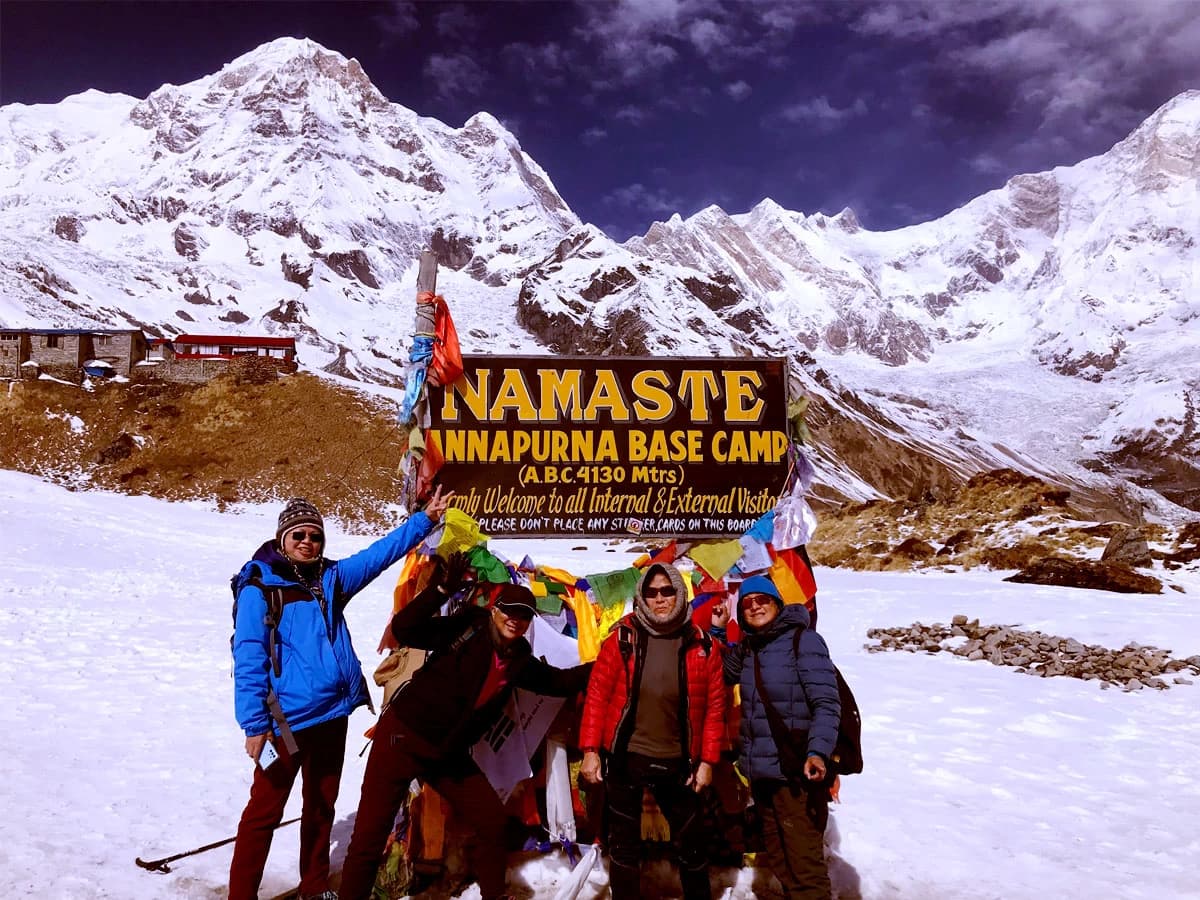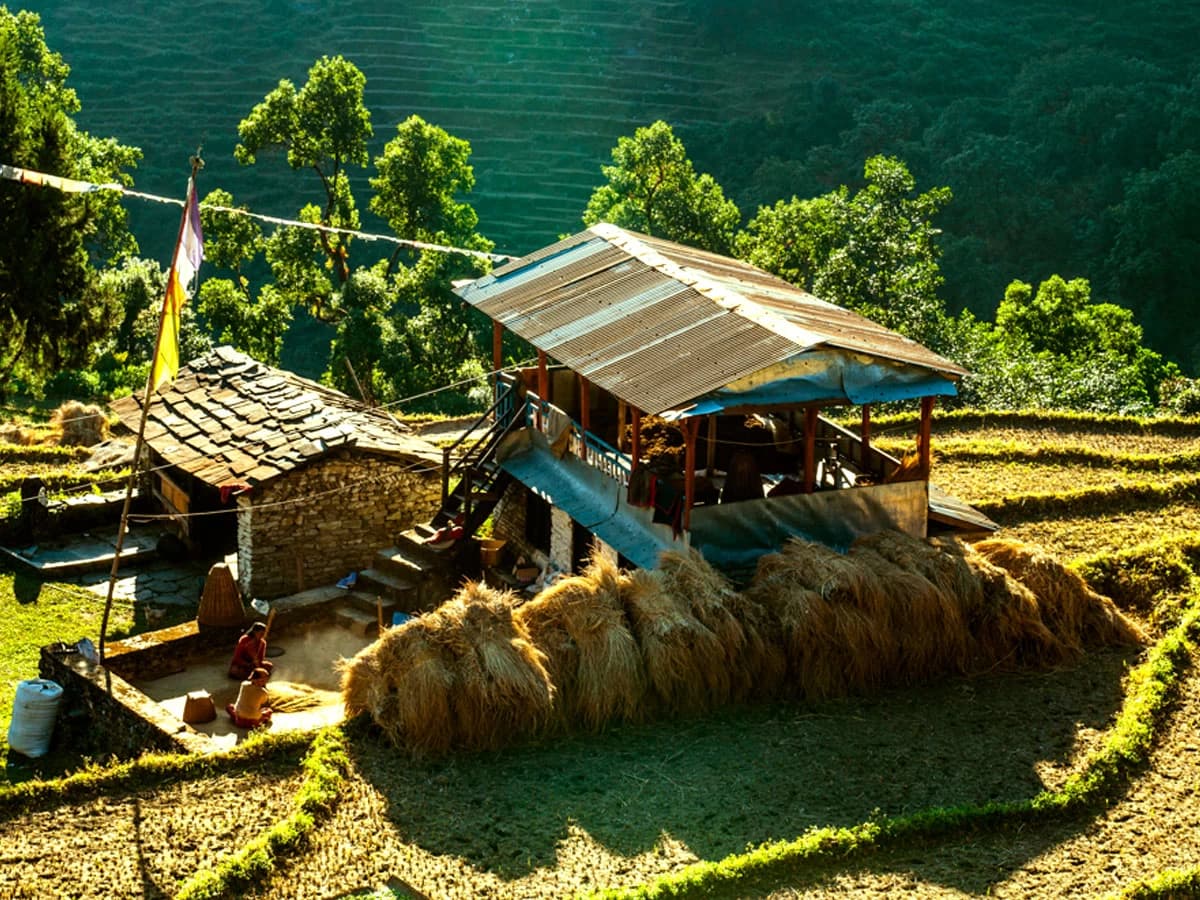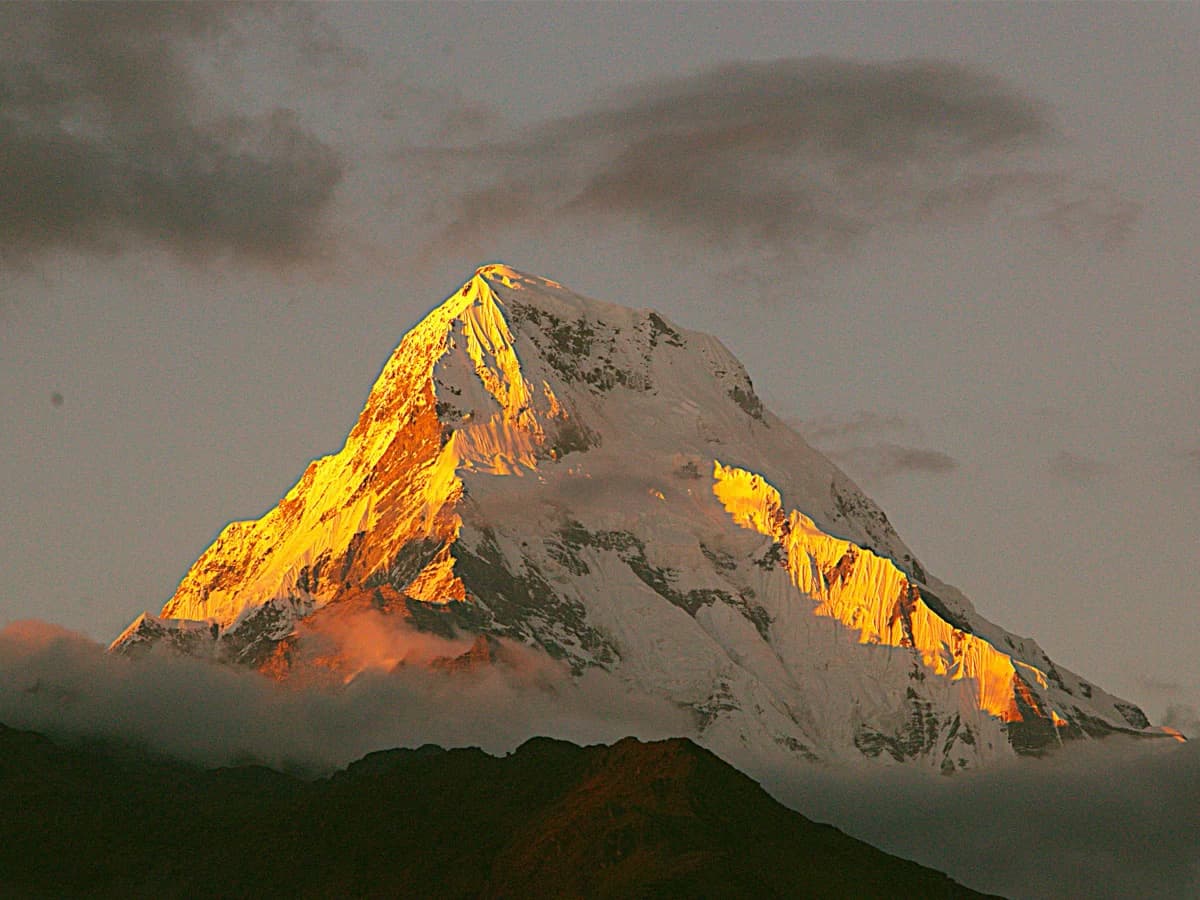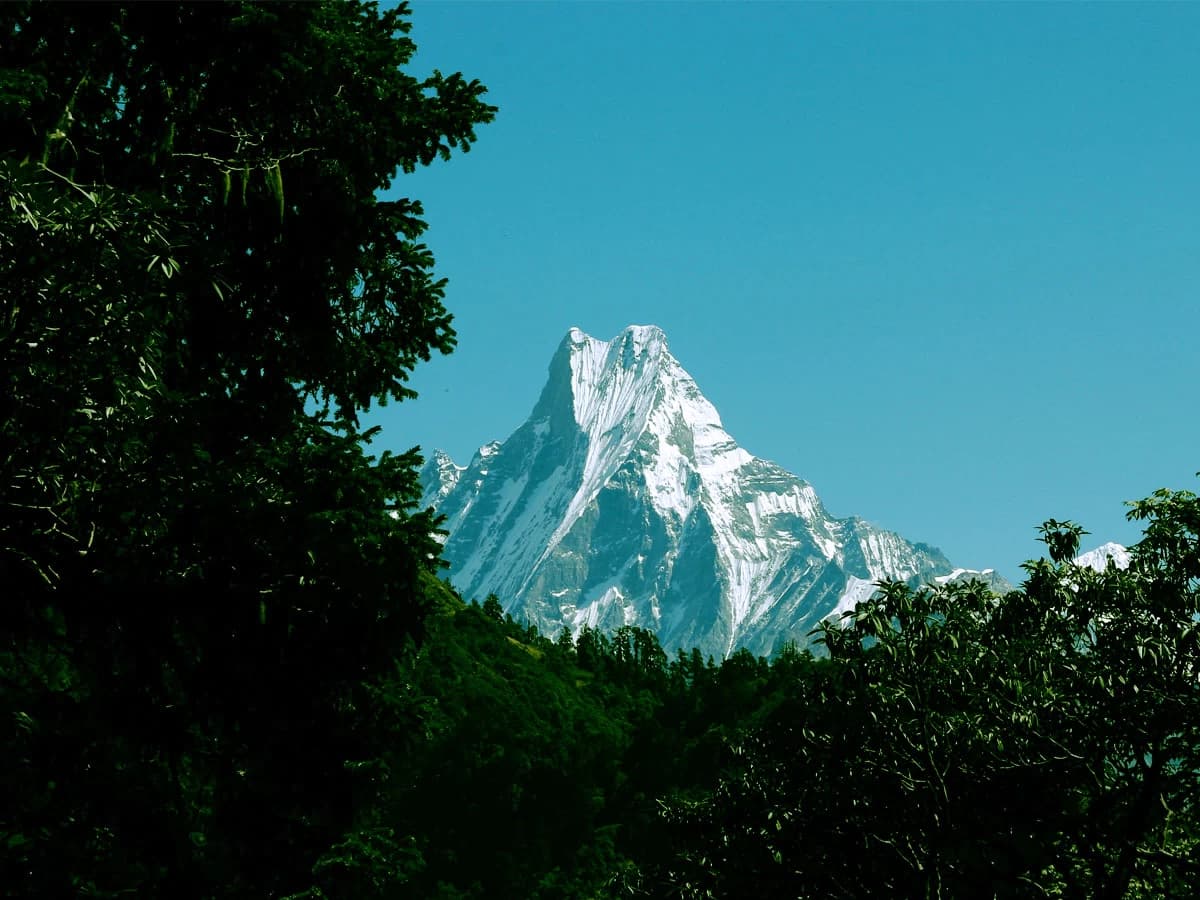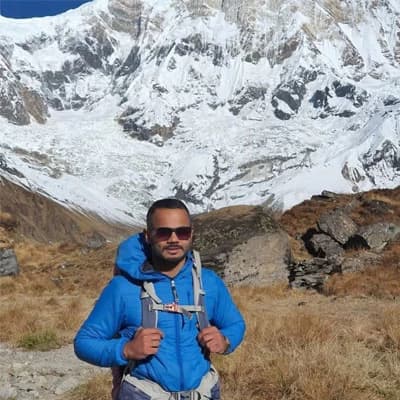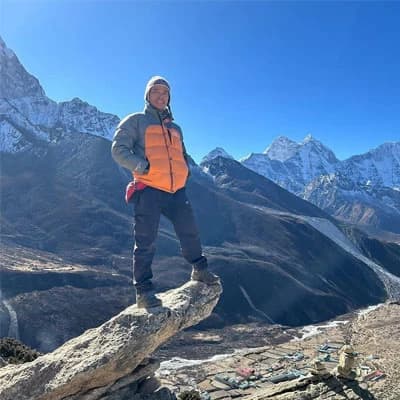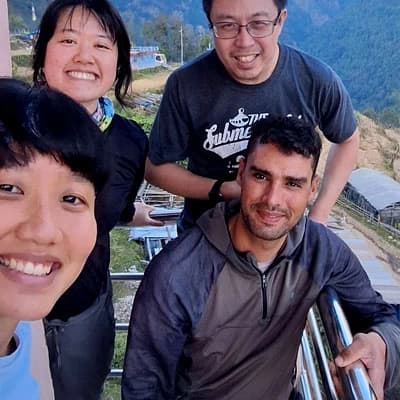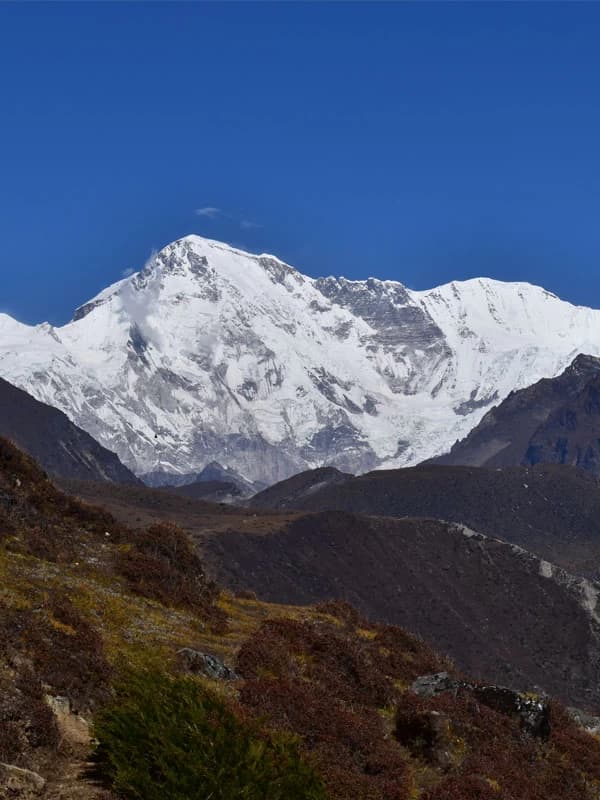The Annapurna Base Camp Trek takes you through the incredible beauty of the Himalayas, offering beautiful sunrises, varied landscapes, and a glimpse into the rich local culture of villages like Ghandruk and Chhomrong. Along the trail, you’ll cross exciting suspension bridges, walk through green forests, and enjoy amazing mountain views. The journey is made even more special with peaceful moments, like soaking in the natural hot springs at Jhinu Danda, making it a truly unforgettable adventure suitable for trekkers of all levels.
Annapurna Base Camp Trek
Highlights: Annapurna Base Camp Trek
- Immerse yourself in 360-degree views of the mighty Himalayan peaks, including Annapurna I (8091m), the 10th highest mountain in the world.
- Trek to two iconic base camps, Annapurna and Machhapuchhre, for an unforgettable mountain adventure.
- Admire the striking Machhapuchhre, or Fishtail, peak - a natural marvel that dominates the skyline.
- Start your day with a mesmerizing sunrise over the Annapurna range, bathing the peaks in golden hues.
- Explore charming villages like Ghandruk and Chomrong, home to the Gurung and Magar communities, and learn about their rich traditions.
- Walk through rhododendron forests bursting with vibrant colors during spring, creating an enchanting backdrop.
- Relax in the soothing natural hot springs at Jhinu Danda, a perfect retreat after your trek.
- Experience diverse landscapes, from subtropical greenery to icy alpine terrains, all within a single trek.
- Begin and end your journey in Pokhara, a vibrant city offering serene lakeside and cultural experiences.
Annapurna Sanctuary Trek Overview
The 10-day Annapurna Base Camp Trekking adventure takes you deep into the heart of Nepal’s Himalayas, offering a blend of Annapurna mountain range exploration, cultural immersion, and natural beauty. Starting from Pokhara, the gateway to Annapurna Base Camp, the journey leads through diverse terrains, from subtropical forests to high alpine meadows, and culminates at the breathtaking Annapurna Sanctuary Trek at 4,130m.
Along the trail, you’ll enjoy uninterrupted views of majestic peaks, including Annapurna I, Annapurna South, Mt. Machhapuchhre (Fishtail), and Hiunchuli. A major highlight is the 360-degree panoramic view of the towering Himalayas from Annapurna Base Camp, a sight that will leave you in awe. Many trekkers also enjoy trekking to Machhapuchhre Base Camp on the way to Annapurna, adding an extra layer of excitement to the adventure.
The trek is not just about nature but also about experiencing the rich local culture. Walking through Ghandruk, a charming Gurung village, and hiking through Chhomrong, the last major settlement en route to the base camp, you’ll encounter warm hospitality from Gurung and Magar communities, celebrated for their traditions and vibrant lifestyles. Staying in cozy teahouses enhances this cultural connection, offering local delicacies and insight into the region’s heritage.
The trail is dotted with natural wonders like vivid rhododendron forests, cascading waterfalls, and glacier-fed rivers. Discover bamboo forests around Bamboo and Dovan, and enjoy the soothing natural hot springs at Jhinu Danda for relaxation after days of trekking. Whether you’re an experienced adventurer or a first-time trekker, the ABC Trek provides a fulfilling journey with a relatively easy route, gradual altitude gain, and a manageable timeframe.
Annapurna Base Camp Trek Itinerary
On Day 1, your adventure begins with a scenic 1.5-hour drive from Pokhara to Nayapul, following the tranquil Baglung-Pokhara highway. Upon reaching Nayapul, you’ll set off on foot, walking through charming villages, terraced fields, and lush greenery.
The trail is gentle at first, making for a pleasant start. However, the final stretch to Ulleri involves a steep uphill climb for about 2 hours. Though challenging, this section offers a glimpse of your trekking endurance while rewarding you with mesmerizing views of the surrounding hills and valleys. You’ll rest for the night in Ulleri, a picturesque village with warm hospitality, setting the tone for the days ahead.
Today's trek takes you from Ulleri to Ghorepani, ascending gradually into the heart of the Annapurna Conservation Area. The trail winds through forests filled with rhododendrons, juniper, birch, and fir trees, creating a tranquil and vibrant atmosphere. Along the way, you’ll pass charming hamlets like Banthanti and Nagthanti, offering glimpses of local life and culture.
As you emerge from the dense forest, a gentler slope leads you closer to Ghorepani, situated just below the famous Poon Hill viewpoint. The area is dotted with cozy tea houses, where you’ll spend the night, surrounded by natural beauty and breathtaking mountain views.
The third day begins early with a pre-dawn hike to Poon Hill, one of the most iconic viewpoints in the Annapurna region. Using headlamps, you'll ascend gradually to witness a stunning sunrise over the Himalayan giants, including Mt. Dhaulagiri (8,167m), Annapurna I-IV, Machhapuchhre, and many others. The golden glow over these majestic peaks is a sight you’ll cherish forever.
After descending to Ghorepani for breakfast, the trek continues towards Tadapani through a peaceful trail lined with lush forests and small streams. The gentle descent offers plenty of opportunities to soak in the natural beauty before reaching Tadapani, where you’ll rest for the night amidst serene surroundings.
Today's trail weaves through charming villages and serene woodlands of the Kaski district, offering a peaceful atmosphere and occasional glimpses of Annapurna South, Machhapuchhre, and Hiunchuli. The descent begins gradually before becoming steeper as you approach Kimrong Khola, creating a mix of steady and challenging sections.
After crossing the Kimrong Khola, the path climbs uphill through beautiful settlements like Ghurjung and Talung. The trek concludes at Chhomrong, a hilltop village that rewards you with stunning views of the surrounding Himalayan peaks, making it a perfect place to relax for the evening.
After breakfast, the day begins with a steep descent to the Chhomrong Khola, followed by a challenging uphill climb. The trail involves multiple ascents and descents, keeping the journey dynamic and engaging. Upon reaching Sinuwa Village, the path levels out, offering a more gradual trek before descending for an hour to Dovan.
Along the way, you'll walk through serene forests filled with rhododendron trees, accompanied by stunning views of the natural surroundings. Once in Dovan, you can unwind and explore the quiet charm of this small village before staying overnight at a cozy teahouse.
The trek from Dovan to Deurali is short and scenic, passing through bamboo and rhododendron forests. As we walk, majestic peaks like Annapurna South and Machapuchhre greet us, making for an awe-inspiring backdrop. After stopping for lunch at the Himalayan Hotel, you’ll continue for another two hours, reaching Deurali in the afternoon.
On this easy walk, we’ll pass landmarks like the Himalaya Hotel (2,920m) and Hinku Cave (3,170m). From Deurali, you’ll enjoy views of a large Buddha statue on a rocky cliff, while the surrounding area is filled with dramatic mountain views, mist, and pristine waterfalls. We will spend the night in a local teahouse, soaking in the peaceful surroundings.
Today, we start our trek towards Annapurna Base Camp (ABC), passing through Machhapuchhre Base Camp (MBC) at 3,700m. The trail begins with a gentle climb, followed by a flat stretch along the river, and then a gradual ascent to MBC. Along the way, stunning views of the Annapurna and Machhapuchhre ranges come into view.
From MBC, a short hike leads us to ABC at 4,130m, where we’ll stop for lunch with panoramic views of the surrounding peaks. As the day comes to an end, the sunset casts golden and red hues on Machhapuchhre, creating a magical scene. We will spend the night at ABC, surrounded by the stunning Annapurna Massif.
On Day 8, we start the day early at 5:30 a.m. to witness the first golden rays of sunlight illuminating the Annapurna Massif. After breakfast at the tea house in ABC, we begin our descent, retracing our steps through Machhapuchhre Base Camp, Deurali, Himalaya, and Dovan.
We’ll stop for lunch at Dovan and continue for another two hours before reaching Bamboo, where we’ll rest and spend the night.
Today, we'll continue our journey through Chhomrong, following a steep trail and crossing the Chhomrong River. The route will lead us to Jhinu Danda, a village known for its relaxing hot springs, which are a great way to unwind after a long trek.
After retracing our path through scenic forests, we’ll descend from Chhomrong to Jhinu. We recommend leaving early from Bamboo so you can reach Jhinu in about 5 hours, enjoy a delicious lunch, and spend the afternoon soaking in the natural hot springs to relax your muscles.
On Day 10, we’ll begin the trek with breakfast at Jhinu before heading towards Tolkha. The trail takes us through charming terraced fields and scenic landscapes, making for a pleasant walk.
Upon reaching Tolkha, we’ll board a bus to Pokhara for a relaxing end to the trek. The journey offers a comfortable transfer back to the city, where you can unwind after the adventure.
Annapurna Base Camp Trek Route Map
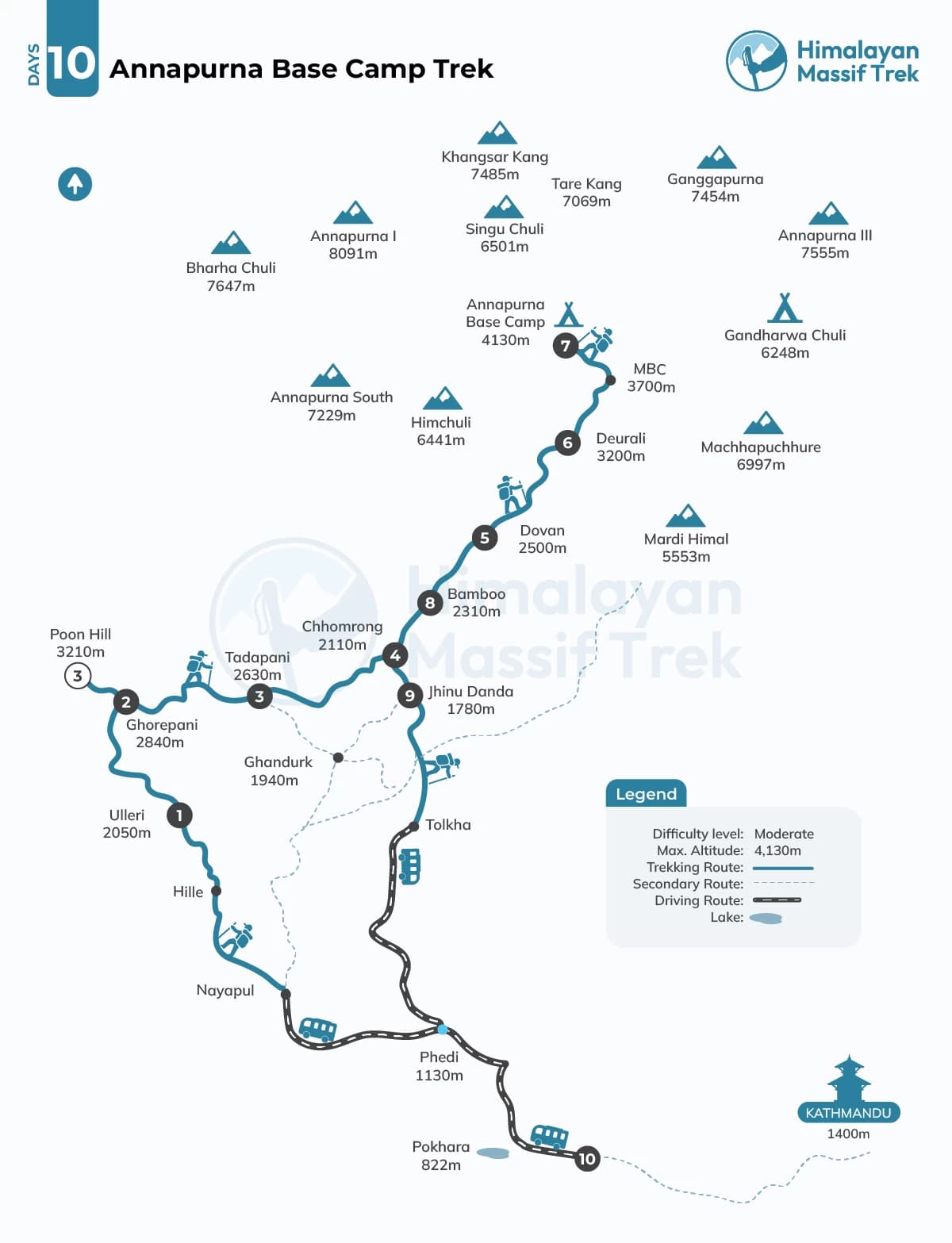

Cost Details
Meals:
- 3 standard meals a day during the trek
- Set of breakfast, Lunch and Dinner
Accommodation:
- 9 nights Lodge accommodation (Private room and common bathroom)
Transportation:
- Transport from Pokhara and return, including hotel pick and drop
Permit:
- All the necessary permits for this trek
Guide and porters:
- An experienced English-speaking guide
- Strong porters sharing between two members
Trekking Gears:
- Sleeping bag and down jacket to use for the trek
- First aid medical kit
Miscellaneous:
- Salary, food and accommodation for guide and porters
- Government taxes and liabilities
- Hot and cold beverage
- Phone calls, internet, hot shower and laundry bills
- Travel insurance and Nepal entry visa fees
- Tip and for guide and porters
To confirm your payment, a deposit payment is required, which is 30% of the total booking price. This deposit helps us secure permits, logistics, and other necessary arrangements for your trek.
We understand that plans can change, and we strive to be as flexible as possible. However, to cover operational costs, a cancellation fee applies. This is a percentage of your total booking price and is deducted from the deposit payment.
Cancellation Fees
Cancel 30% days before departure: 5% of the trip cost
Cancel between 10 to 30 days before departure: 10% of the trip cost
Cancel within 10 days of departure: 20% of the trip cost
If you need to cancel, please notify us as early as possible to reduce charges.
Rescheduling
Unexpected circumstances can disrupt travel plans, even if you still want to do the trip. To support our clients, we have generously waived all rescheduling fees. You can postpone and reschedule your trip at no additional cost, as long as the new departure date falls within one year of your original booking.
Upgrades
If you wish to upgrade your accommodation, transportation, or any other services not mentioned in the Trip Includes section, please be aware that these upgrades will incur additional costs. We can assist in arranging these options for you based on your preferences and availability.
Dates & Availability
Private TripIf you don't find an appropriate date, you can propose a Preferred Departure Date, and we’ll ensure the trip runs as scheduled just for you.
Trip Gallery
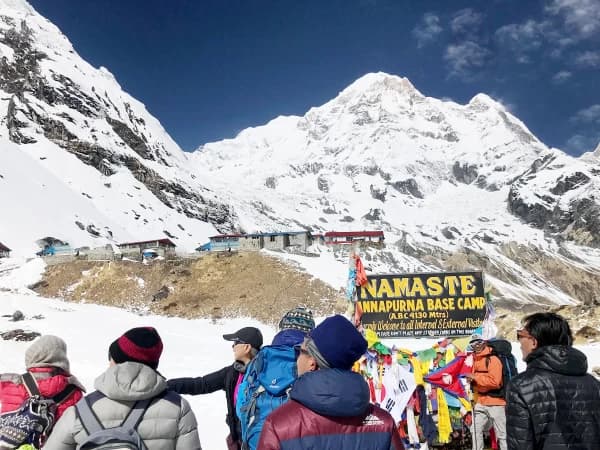

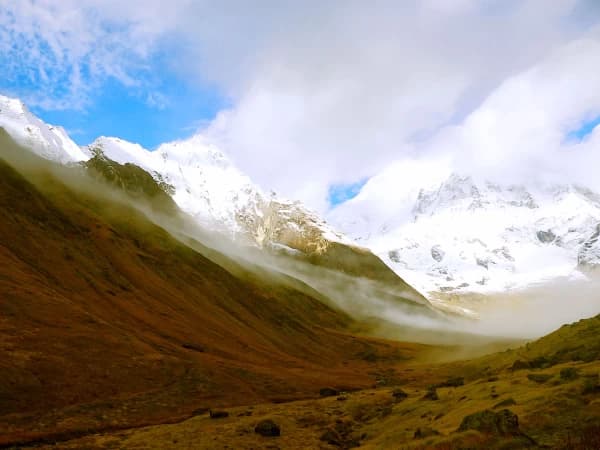
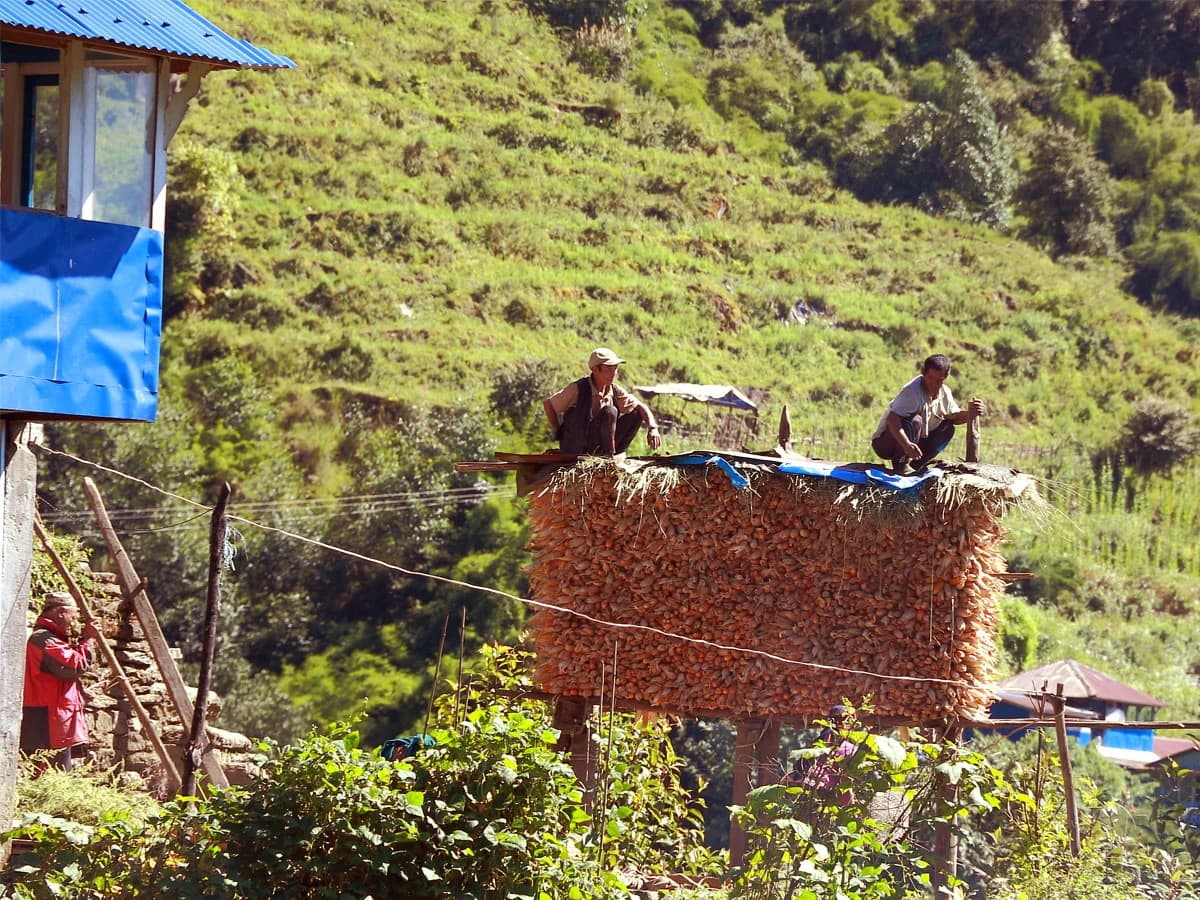
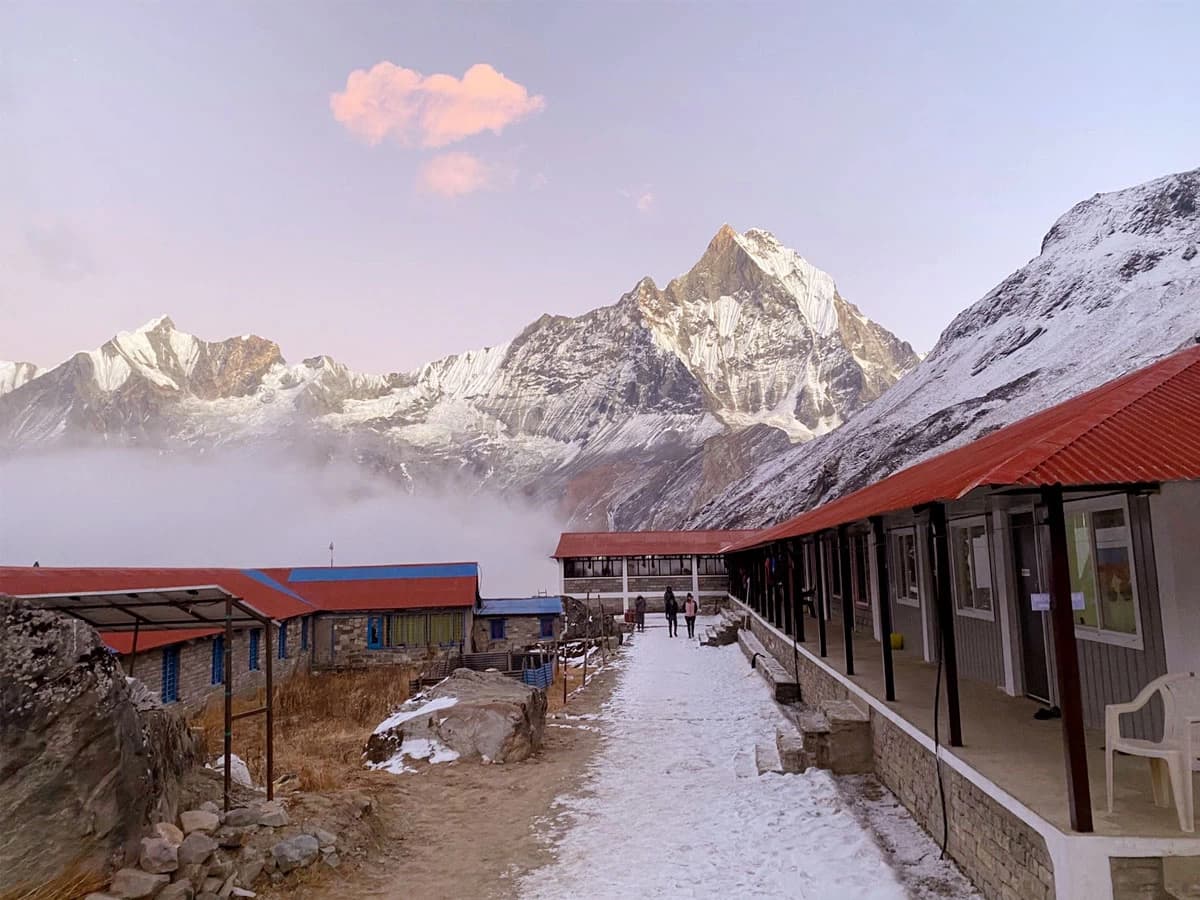
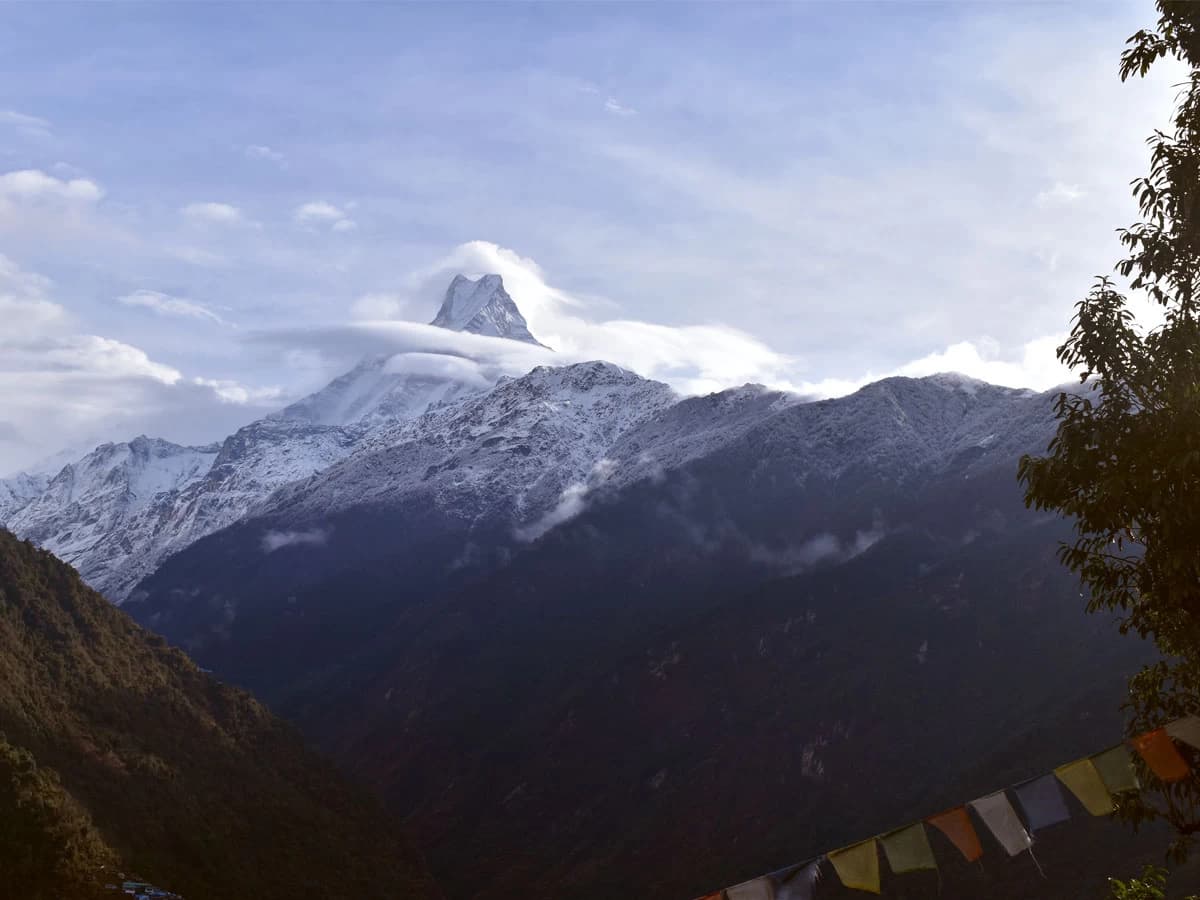
Essential Information
ABC Trek vs. Everest Base Camp
The Annapurna Base Camp Trekking is easily accessible by road, with a scenic bus ride or short flight to Pokhara, Nepal’s vibrant tourist hub. In contrast, reaching Everest Base Camp (EBC) typically involves a flight from Kathmandu to Lukla, saving time but limiting overland travel options. Both treks offer amazing experiences, but the accessibility of the Annapurna Base Camp Hike makes it a more flexible choice for many.
The duration of these treks varies depending on the route you choose. The ABC Trek can be completed in as few as five days or extended to twenty days by including highlights like Tilicho Lake and Muktinath. Meanwhile, the EBC trek typically takes around 12 to 14 days, with acclimatization days to adjust to the higher altitudes. For those short on time, a helicopter return is also an option for EBC.
In terms of difficulty, the Annapurna Trek to base camp is less demanding, with a maximum altitude of 4,130m. On the other hand, the EBC trek reaches 5,364m, with Kala Patthar offering even higher views at 5,555m. The higher altitude and colder temperatures make EBC more challenging, requiring better fitness and acclimatization. For Annapurna Base Camp Guided Trek, trekkers can expect a more moderate pace, allowing more comfort at lower altitudes.
Similarly, cost-wise, the Annapurna Sanctuary Trek is typically more affordable due to its shorter duration and easier accessibility. Trekking to EBC, being more remote and longer generally costs more. However, group sizes and preferences significantly influence the expenses on both treks.
The landscapes and cultural experiences differ greatly. Annapurna mountain range exploration showcases diverse terrains, from subtropical forests to alpine meadows, alongside villages of Gurung and Magar communities. In comparison, the EBC trek, while less varied, immerses you in Sherpa culture and offers glorious views of the towering Himalayan peaks. Both treks offer unique wildlife encounters and unforgettable natural beauty, leaving trekkers with lasting memories.
Best Time for Adventure Enthusiasts on the Annapurna Base Camp Trek
Choosing the right time for your Annapurna Base Camp Trekking adventure is key to having an unforgettable experience. The two best seasons for trekking are Spring (March-May) and Autumn (September-November), each offering distinct advantages for trekkers.
Spring (March-May)
Spring is a favorite for many trekkers. The weather is mild with clear skies, providing stunning views of the Himalayas during your Annapurna Base Camp Hike. Daytime temperatures range from 10°C to 20°C, but they can drop below 0°C at higher altitudes at night. The trails come alive with vibrant colors as rhododendrons bloom, creating beautiful scenery along the Annapurna Sanctuary Trek and making it an ideal time for Annapurna Trek for adventure enthusiasts.
Autumn (September-November)
Autumn is another excellent time to trek in the Annapurna region. The weather remains pleasant with clear skies and moderate temperatures, perfect for Annapurna Base Camp Guided Tre. While it’s a busy season, the beautiful autumn colors and lively atmosphere in Nepal make it a rewarding experience for those exploring Pokhara, the gateway to the Annapurna Base Camp Trekking.
Summer (June-August)
Trekking in summer is possible, but it’s not ideal due to monsoon rains. The trails can be slippery, and the weather unpredictable, making it more suitable for experienced trekkers. If you choose to trek during this season, you’ll need waterproof gear and sturdy shoes and be prepared for possible delays. For those seeking a challenge, the high-altitude Annapurna Base Camp trek during this period may offer a more secluded adventure.
Winter (December-February)
Winter trekking can be tough due to cold temperatures, snow, and slippery trails. However, for experienced trekkers seeking a quieter, more adventurous experience, winter offers fewer crowds and clear skies, especially for those looking to experience the grandeur of Annapurna South during the Annapurna Sanctuary Trek. Winter trekkers can also enjoy walking through Ghandruk, a picturesque Gurung village, with fewer people around and stunning views of the surrounding mountains.
Accommodation on the Annapurna Base Camp Hike
On the Annapurna Base Camp Trekking, you'll find a range of accommodations such as tea houses, mountain lodges, and homestays, all contributing to the authentic experience of the Annapurna mountain range exploration. There's no need to camp unless that's your preference.
During peak season, it’s best to book your room in advance as accommodations can fill up quickly. In some cases, trekkers might need to stay in the dining hall due to room shortages.
Tea Houses
Tea houses are the most common accommodation along the Annapurna Trek to Base Camp. These small, locally owned lodges offer twin rooms, a communal dining area, and shared bathrooms, often with squat toilets. They range from basic to more comfortable, with some offering Wi-Fi and hot showers. Tea houses provide a warm, friendly environment where trekkers can relax, share stories, and get trail updates as they continue their Annapurna Base Camp Hike.
Mountain Lodges or Guest Houses
Mountain lodges are larger and cozier than tea houses, typically found on routes like the Annapurna Sanctuary Trek. They often offer private bathrooms, hot showers, and sometimes Western meals. Some even provide extra comforts like electric blankets and free Wi-Fi. These lodges are located in bigger villages and offer stunning views of the Annapurna mountain range, including a chance to enjoy witnessing the grandeur of Annapurna South from the base camp.
Homestays
Homestays allow trekkers to stay with local families in traditional Gurung villages like Ghandruk and Ghorepani. This is a great way to experience Nepali culture and learn about daily life in the mountains while trekking to Machhapuchhre Base Camp on the way to Annapurna. Homestays offer a more intimate and cultural experience as you connect directly with the people who call the Himalayas home.
Camping
For those seeking a more traditional experience, camping is an option. However, it requires carrying all your camping gear, so porters are recommended. While it’s a more remote experience, it can be challenging, especially on the high-altitude Annapurna Base Camp Trek where the environment becomes more rugged as you ascend through bamboo forests around Bamboo and Dovan.
What to Expect at Tea Houses and Lodges
Most tea houses and lodges are simple but sturdy, with stone walls and basic furnishings. You’ll use shared facilities like squat toilets, and may not always have running water. The communal dining areas, heated by a fireplace, are great for sharing meals and stories with fellow trekkers on their Annapurna Sanctuary Trek. Solar power is used for lighting, and charging stations are available in the common areas for your devices.
Bathrooms
At lower elevations, you might find private Western-style toilets, but higher up, you’ll mostly use shared squat toilets. Water may not always be running, but containerized water will be provided. Hot showers are available for a fee, but it's best to keep showers infrequent due to the cold weather on your Annapurna Base Camp Trekking journey.
Internet and Power
Wi-Fi is available in some lodges but can be unreliable, especially at higher altitudes along the Annapurna Base Camp Trek. It's better to use mobile data if needed. Solar or hydroelectric power is used for lighting, and charging stations are provided in the common areas for devices.
Drinking Water on the Route
Staying hydrated is crucial as you trek at higher altitudes, where you'll be breathing more and losing more water. To help prevent altitude sickness and keep your energy up, make sure to drink plenty of water throughout your Annapurna Base Camp Guided Trek.
While bottled water is available along the route, it’s better for the environment to use a reusable water bottle. You can purify water using purification tablets or buy boiled water from tea houses. It’s important to avoid drinking from local taps, rivers, or wells, as the water may not be safe.
In addition to water, you’ll find warm drinks like tea and coffee at tea houses. Black tea, herbal tea, and masala tea are popular choices, while you can also enjoy Nepali coffee or instant coffee for a caffeine boost.
Some tea houses offer soft drinks and fruit juices, though these can be expensive due to the difficulty of transporting them to remote areas. You may also come across local drinks like apple brandy or fruit wines. While these are part of the local culture, it’s best to avoid alcohol, especially at high altitudes, as it can be harmful to your health and hinder your ability to cope with the Annapurna trek for adventure enthusiasts.
Food Options on the High-Altitude Annapurna Base Camp Trek
During the Annapurna Base Camp Trekking, it’s important to stay nourished. While the food may be simpler than in cities, you'll find delicious and healthy options along the route. A popular dish is Dal Bhat Tarkari, which consists of rice (Bhat), lentil soup (Dal), and vegetable curry (Tarkari), often served with pickles. It’s a great source of energy for the trek, especially on your Annapurna Base Camp Hike.
Another must-try is Momos, dumplings filled with vegetables or meat like chicken or buffalo, served with a tangy dipping sauce. You’ll also find noodle dishes and pasta, offering a change from rice-based meals on your Annapurna Base Camp Guided Trek. In larger settlements, international options like pizza, burgers, and pancakes are available, providing a welcome taste of home after your Annapurna trek to base camp.
For something unique, try local specialties such as yak meat burgers, buckwheat-based dishes, and Gundruk, made from fermented leafy vegetables. These dishes give you a true taste of the Annapurna mountain range exploration. Snacks like energy bars, chocolate, nuts, and dried fruits are also available to keep your energy up, especially during the more strenuous sections of your high-altitude Annapurna Base Camp Trek.
Most teahouses along the trek offer vegetarian and vegan options, but if you have dietary restrictions, it’s best to inform them in advance. Keep in mind that food options may become more limited and expensive at higher altitudes, especially as you trek through areas like Bamboo and Dovan. As you approach Annapurna Sanctuary, it’s important to plan accordingly since the Annapurna Trek can take you to remote regions where provisions are more difficult to source.
Trek Permits Needed for Annapurna Base Camp Trekking
When preparing for your Annapurna Trek to base camp, securing the proper permits is essential. For the Annapurna Base Camp Hike, you’ll need two primary permits: the Annapurna Conservation Area Permit (ACAP) and the TIMS (Trekkers' Information Management System) Card. The ACAP helps conserve the natural beauty and biodiversity of the Annapurna mountain range exploration, while the TIMS card allows authorities to monitor trekkers' safety, ensuring a secure journey through this stunning region.
Both permits can be easily obtained in Pokhara, the gateway to the Annapurna Base Camp Trekking, or Kathmandu. To apply, simply bring your passport. The process is quick, and trekking agencies can also assist in securing these permits for you, making the start of your Annapurna Base Camp Guided Trek even more hassle-free.
Once you have the ACAP and TIMS cards, remember to carry them during your trek. They will be checked along the Annapurna Sanctuary Trek, including while hiking through Chhomrong, and other key areas. It's also advisable to carry photocopies as a backup in case of loss.
By obtaining these permits, you’re not only ensuring your safety on the high-altitude Annapurna Base Camp Trek but also contributing to the preservation of the incredible landscapes, traditional Gurung villages, and rich culture that make the Annapurna Base Camp Trek a life-changing adventure.
Annapurna Base Camp Trek Equipment List
FAQs
Annapurna Base Camp is situated in the Annapurna region of Nepal, within the Annapurna Conservation Area.
A typical itinerary includes visits to Nayapul, Ghorepani, Poon Hill, Tadapani, Chomrong, Dovan, Deurali, Machapuchhare Base Camp, and concludes at Annapurna Base Camp.
What is the altitude of Annapurna Base Camp?
Annapurna Base Camp is located at an elevation of 4,130 meters (13,550 feet).
The ideal time to trek to Annapurna Base Camp is during the spring (March to May) and autumn (September to November) seasons.
Trekking to Annapurna Base Camp without a guide is not allowed. As of April 1st, 2023, solo trekking in the Annapurna region has been banned, and a guide is required to obtain a TIMS Card.
Yes, trekkers are required to have a TIMS (Trekkers’ Information Management System) card and an Annapurna Conservation Area Permit (ACAP).
To get ready for the trek, focus on improving your stamina and strength. Try activities like jogging, walking, hiking, or cycling a few times a week to build your endurance.
Adding stair climbing to your routine is a great idea since it prepares you for the uphill sections of the trail. Simple exercises like squats, lunges, and planks will also help strengthen your legs and core, making the trek more manageable.
The daily trekking distance usually ranges between 10 to 15 kilometers, requiring 5 to 7 hours of walking.
It is classified as moderately challenging, requiring several hours of trekking each day on diverse terrain with both ascents and descents. Good physical fitness and some prior trekking experience are recommended.
Although the Annapurna Base Camp Trek is classified as moderate in difficulty, it may still pose challenges for beginners due to its altitude and duration. Adequate preparation and fitness are important for this trek.
Yes, Wi-Fi is available at some teahouses, but the connection is often slow and unreliable, especially in higher-altitude areas. A small fee is typically charged for access, so it’s better to inform your family in advance about the limited connectivity.
There are no ATMs along the trekking route, so bringing enough cash for the entire trek is recommended.
Accommodation is generally in teahouses or lodges, where basic facilities include meals and simple rooms.
Travel insurance is highly recommended for the Annapurna Base Camp Trek. It should cover emergency medical expenses and helicopter evacuation up to 4,130 meters, including trekking and altitude coverage. Verify with your provider that these are included, as they may not be part of standard policies.
In case of a medical emergency, the guide will evaluate the situation and offer immediate first aid. If evacuation is needed, the guide will arrange for a helicopter rescue, as long as your insurance covers it. Trekkers should follow the guide’s instructions and inform them about any health concerns as soon as possible.
Basic medical services can be found in the larger villages, but for more serious conditions, evacuation to Pokhara or Kathmandu may be necessary.
Your first aid kit should include bandages, antiseptic wipes, pain relievers, medication for altitude sickness, blister treatment, and any personal medications you may need.
To prevent altitude sickness, ascend gradually, stay well-hydrated, avoid alcohol, and use Diamox if recommended by a doctor.
It is recommended to get vaccinations for Hepatitis A, Typhoid, and Tetanus. Consulting a travel health specialist for tailored advice is essential.
Yes, vegetarian options are commonly available, as many locals follow a vegetarian diet. Vegan options can also be provided, but it’s a good idea to confirm with the teahouse staff, as some dishes may contain ghee (clarified butter) or other animal products.
The food along the Annapurna Base Camp trek is generally simple but nutritious. You can enjoy Nepali dishes like rice, lentils, and vegetable curries (dal bhat), as well as Tibetan-style food like momos (dumplings) and noodle soups. Most teahouses also offer Western options, including pasta, pancakes, and omelets.
Tap water is unsafe to drink. It's better to use water purification tablets or opt for bottled or boiled water.
Some areas may be susceptible to avalanches or landslides, particularly after heavy rain or snowfall. It is important to follow your guide's advice to stay safe.
Mountain weather can change quickly, so it's important to be ready for cold temperatures, especially at higher altitudes. Make sure to pack suitable clothing for varying conditions.
Wildlife encounters are rare, but it's important to stay cautious, especially around yaks on the trail. Avoid feeding or approaching wild animals to ensure your safety.
Begin each day early to avoid the midday heat and ensure you reach the next teahouse with enough time before it gets dark.
Expertise and Local Knowledge
With experienced guides who know the Annapurna mountain range, you’ll feel confident navigating the trails. The team comprises locals who bring unmatched knowledge of the terrain, culture, and traditions. Decades of trekking expertise ensure every aspect of your Annapurna Trek is thoughtfully planned for a safe and memorable experience.
Authentic Local Experiences
Your Annapurna Base Camp Hike isn’t just about stunning views - it’s also about connecting with the heart of Nepal. You’ll explore charming traditional Gurung villages like Ghandruk and Chhomrong while enjoying traditional Nepali meals and immersing yourself in the warm hospitality of local communities. Himalayan Massif Trek crafts each itinerary to offer genuine insights into the region's culture and traditions.
Great Value for Your Adventure
Himalayan Massif Trek offers competitive pricing with transparent, all-inclusive packages designed for a stress-free experience. From permits and accommodations to meals, every detail is taken care of, so you can focus entirely on the journey. Special discounts for groups and returning trekkers make this adventure even more accessible, ensuring exceptional value without compromising quality or comfort on your Annapurna Sanctuary Trek.
Environmentally Responsible Trekking
Himalayan Massif Trek is committed to preserving the pristine beauty of the Annapurna region. We adopt eco-friendly trekking practices, minimize environmental impact, and support local suppliers, contributing directly to the community. Your trek becomes part of a larger effort to protect the environment while uplifting local livelihoods. Whether you are exploring the bamboo forests around Bamboo and Dovan or hiking through Chhomrong, you can be assured that your experience is contributing to the sustainable development of this stunning region.
- Expertise in High-Altitude Trekking Adventures
- Over 18 Years of Experience in The Himalayas
- Authorized and Reliable Trekking Partner
- Trusted by Thousands of Adventurers Worldwide

The Annapurna Base Camp trek was a must-do experience. The team was professional and made sure we had a great time.
This trek was a perfect blend of cultural experiences and natural beauty. The trails were well-maintained, and the lodges were comfortable. The guides were knowledgeable...
The Annapurna Base Camp trek was absolutely stunning. The scenery was diverse, and the views of Annapurna were breathtaking. The team at Himalayan Massif Trek...
